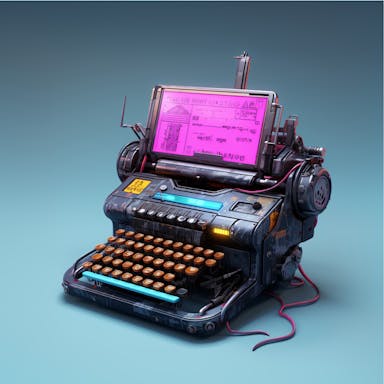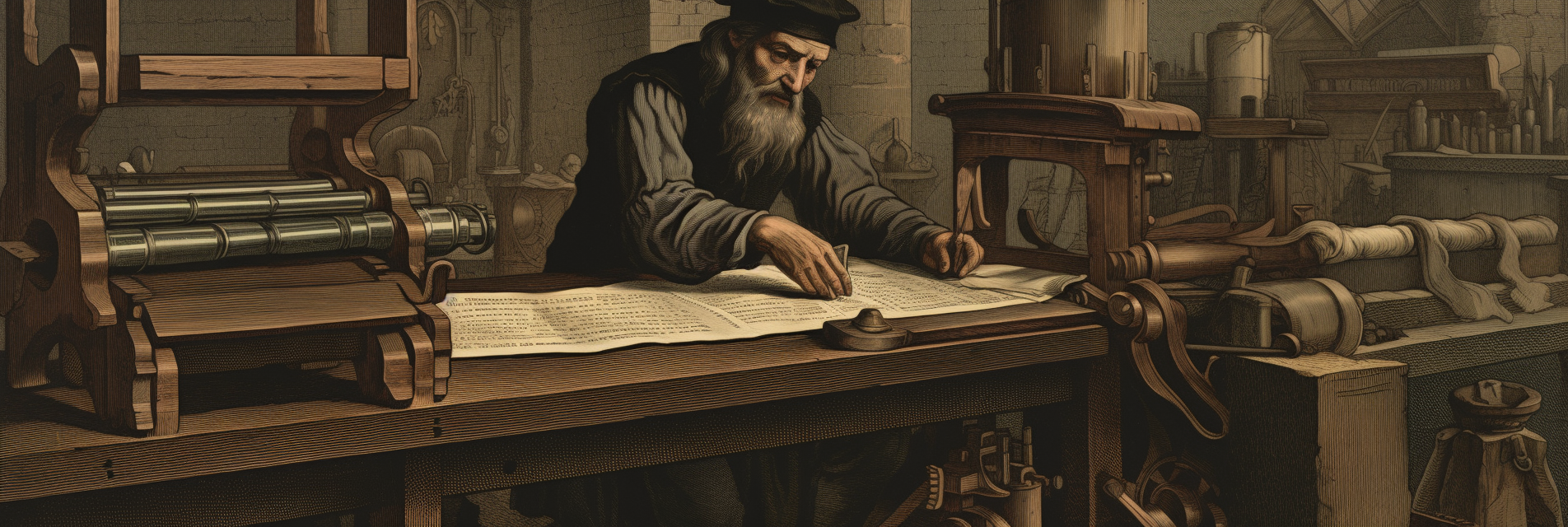I had a lot of fun this month releasing of a collection of profile pictures, or PFPs, themed on 15th-Century bible publisher Johannes Gutenberg. The Gutenberg-themed "Gutencasts" are intended to start a conversation about new publishing technologies while fostering a community dedicated to innovative book projects, formats, and concepts.

Who was Johannes Gutenberg?
Johannes Gutenberg was a German blacksmith, goldsmith, inventor, printer, and publisher who introduced the concept of movable type printing to Europe in the 15th century. His revolutionary invention, the Gutenberg press, transformed the process of printing in the West and contributed to the spread of knowledge worldwide.
Gutenberg's invention played a pivotal role in the development of the Renaissance, Reformation, and Age of Enlightenment. His vision created a pathway for mass communication, making it easier for people to access and share information. In bypassing traditional gatekeepers to bring books, learning, and knowledge to the general public, Gutenberg enabled the modern world.
In addition to pulling Europe out of the Middle Ages, Gutenberg's legacy includes the world's twenty-one most valuable books. The complete Gutenberg Bibles that still exist after five-plus centuries are literally priceless. All are held by institutions, and it's been nearly fifty years since one went up for auction.
We may not see a complete Gutenberg go up for sale again in our lifetimes.
Honoring Gutenberg's spirit
The Gutencasts project recognizes Gutenberg's revolutionary spirit in the era of onchain publishing. 555 unique PFPs represent dozens of literary and artistic movements that were enabled by the Gutenberg press.
Each Gutencast pays tribute to publishing's past while looking forward to its decentralized future. Inspired by the transformative impact of the Gutenberg press, the Gutencasts presage a similar transformative potential for the age of blockchain technology.
This collection combines art, history, and technology to engage the global community in a better appreciation for our shared intellectual heritage and future.
A flagship Cryptoversal project
I've had Johannes Gutenberg in mind since I first entered the Web3 space in 2021. The potential for another Gutenberg-scale revolution is possible if Web3 publishing can free ebooks from their proprietary devices, replace lease-to-read schemes with genuine ownership, and bypass the corporate gatekeepers that stand between authors and their reading communities.
Blockchain provenance creates piracy-resistant books. A privacy-first approach can help counter the disturbing trends we've seen toward censorship. And innovative formats provide authors with more opportunities, which in turn will provide the world with more authors, a greater diversity of voices, and democratized access to information. The modern heirs of Gutenberg are poised to kick-start the next Age of Enlightenment.
The first complete book I published to the blockchain was a Gutenberg Bible in 2021 to commemorate the launch of a dedicated book minter by the pioneering Web3 authors guild, PageDAO. As far as I know, the Blockchain Vulgate was the earliest onchain bible.
The Gutencasts PFP collection is launching now to commemorate a new milestone, PageDAO's development of a new and upgraded book-minter. A new publishing technology is about it be unlocked, and the community of Gutencasts holders will have a front row seat.
The Creation Process
The Gutencasts collection includes one hand-drawn design, seventeen hand-colored items, and hundreds of unique AI-prompted designs in a variety of genres.
I'm AI-skeptical, especially when it comes to LLMs that have been trained on copyright-protected works. That said, I was unable to commission 555 unique images of Johannes Gutenberg at any price in any reasonable amount of time. I will always champion human creativity over AI outputs but, in this case, an AI tool enabled a project that would have been impractical or impossible otherwise.
The Gutencasts are divided into dozens of thematic families, representing genres of art and literature. Horror is well represented. There are pirates. There's pop art and impressionist art, cyberpunk, Gutenbergs made from fruit, Gutenbergs made from jellybeans, Gutenbergs on the shore to represent fun beach-reads. Something for every mood and taste.
I wanted the collection to feel like walking into a well-stocked library and seeing all the stacks at the same time. Gradually, the visual chaos is tempered by all of the Gutencasts sharing a common theme. From the earliest board books, to novels, to the encyclopedia, Gutenberg's press enabled them all. This is authorship intersecting with technology in Gutenberg's time and our own.
Izzabook?
Some Gutencasts are Gutenbergs. At the initial mint, a small percentage of holders discovered that their tokens had an "izzabook" trait enabling them to open complete full-color flip-book versions of a complete 1284-page Gutenberg Bible.
The Izzabook Gutenbergs replicate the historic Blockchain Vulgate of 2021. They harness PageDAO technology to embed a standalone reader from decentralized storage. These tokens also have an added feature that the original Blockchain Vulgates didn't. For added durability, holders can use the Darkblock protocol to pull a backup copy from Arweave. They can even send it to a Kindle for added convenience.
Wen utility?
Gutencasts is designed to be a long-term project. Our bar has been set by the physical Gutenbergs, which are still held in diamond hands five centuries after their creation.
At this point, the utility of a physical Gutenberg Bible is as a historical artifact. These are products of Gutenberg's press, tended by Gutenberg's own hands, but they no longer meet our understanding of what books are meant to be. Common folk aren't allowed to read from the Gutenberg Bibles, or even to touch them. If someone gifted you one for free, you'd go broke trying to build a protective environment to keep its ancient pages from deteriorating. Gutenberg Bibles, in their physical form, don't make very practical gifts.
You're actually better off holding a Gutencast. If it's an Izzabook Gutenberg, you can flip through the pages at a speed that would alarm the stewards of the physical versions, or zoom in to read the Latin verses. Experiencing these artifacts as pages and text is what turns them back into books.
I've been laying out some very early plans for the Gutencasts on the CryptoversalBooks.io website, in casts on the /cryptoversal channel of Warpcast.
Gutencasts will allow holders to propose and participate in community publishing projects, and will work as mint-passes for the resulting works. I would also love for the collection to fund a book raffle and literary acquisitions in a library shared by the community.
Additional utility will come from forming a DAO to help authors create original works. The physical Gutenberg may add prestige to a university or library collection but from their vaults they will never provide nearly as much community benefit as a Gutencast.
Minting and more
Gutencasts can be minted from the CryptoversalBooks.io mint page or obtained on the seconary market.

